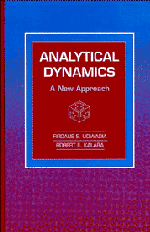Book contents
3 - THE FUNDAMENTAL EQUATION
Published online by Cambridge University Press: 22 March 2010
Summary
Having taken the small detour into matrix algebra in the last chapter, we suggest to the reader at this point to go back to the first chapter and skim over it again, especially so that this time the meaning of equations (1.65) to (1.70) is better understood. In this chapter, the equation of motion for constrained mechanical systems will be formulated. The reader will find that it is not necessary to digest all the intricacies that are broached in the previous chapter. Only a few key results from it will be needed. However, for a deeper understanding of the material in this chapter, we recommend that Chapter 2 be carefully read; for, in doing so, a better grounding of the basics, which we will be using in later chapters, will be obtained.
We begin by starting our discussion on the nature of some elementary constraints. We will introduce the concepts of holonomic and nonholonomic Pfaffian constraints and, in this chapter, we will limit our discussion only to these two types of constraints for they form the backbone of Lagrangian mechanics. However, we will show that the fundamental equation is valid for a much larger class of constraints. Next we will introduce Gauss's principle, which may be taken as our starting point. This principle is somewhat less popular that the principles of Lagrange, Hamilton, Gibbs and Appell; we assure the reader that what Gauss's principle lacks in popularity, it more than makes up for in its tremendous sweep of applicability.
- Type
- Chapter
- Information
- Analytical DynamicsA New Approach, pp. 71 - 105Publisher: Cambridge University PressPrint publication year: 1996

